I’m already expecting the downvotes, but I’ll keep saying this: it’s not acceptable for AMD to sell you a full priced card, in 2024, that doesn’t have hardware acceleration for better upscaling, instead relying on leftover shader compute.
Intel XeSS and DLSS are years ahead. And in this age of TAA being pretty much mandatory on deferred renderers, you can’t even hide behind the “we don’t need upscaling!” false argument.
source: https://gpuopen.com/fidelityfx-super-resolution-3/
FSR Quality preset for 1080p only render at 720p, while DLSS Quality render at whatever next available resolution the fits so it would likely render at 1600x900. It is possible to render with Ultra Quality preset similar to what Avatar developer made at 1.2x upscale, but it does not come in standard. The video have over half of benchmarking using outdated version(only 2 on FSR3) and comparing pretty much different tech. Anyone with decent enough graphics tech knowledge knows it will not have good result with FSR since it does not doing use AI to help filling the missing pixels. AI is surprisingly good when doing upscaling and filling in the details( if you know what those image generator do at internal res and keep upscaling and tweaking the images), while shader solution relies on input information for better work. Means, if the input frame rate or resolution is too low, it’s not gonna work as intended. (similar to the newer optical flow frame gen also rely on frame rate being stable for better frame gen result. )
You don’t have to like AMD nor FSR’s result, but comparing result while ignoring the implementation detail and what are the techs are for is like comparing beer and scotch and then complain why scotch doesn’t give you the burp.
Relying on hardware acceleration for FSR would make it hardware-locked, while one of the benefits of FSR is that it works on all hardware, including game consoles.
And technically, FSR is optimized for AMD hardware, but not in a way that makes it locked down to AMD unlike DLSS and Nvidia.
Personally I prefer their more open position, even though it might mean they’re not as good.
Relying on hardware acceleration for FSR would make it hardware-locked, while one of the benefits of FSR is that it works on all hardware, including game consoles.
Intel’s XeSS will look and perform much better with Intel hardware, but fall back to shaders exactly like FSR on any other platform. In fact, it looks slightly better in that scenario too.
That is the better approach. If Nvidia had done that as the first though, they would be getting a “they are making it look bad on purpose” response. That would be worse than the, it only work on nvidia hardware, response from users. With Microsoft working on a D3D12 upscaling approach, every hardware provider will have a standard interface to make it look best on their hardware.
That said AMD does need to get an AI upscaler. The difference in quality is to great to hand write. At 1080p native it doesn’t matter much as most look pretty, but at higher resolutions, ie 4K, the difference is massive. And it would be best for them to have something ready for futue PS6 and Xbox next.
Found the Nvidia stan…
I didn’t record the video, nor did I create the horrendous FSR artifacts on the games being displayed, so I’m not sure how I’m somehow related to it :)
If you’re not happy with what’s out there, start your own company and see if you can do it better. Engineering is hard, period. Making video games is difficult, hardware is difficult, and making sure you’re price competitive while having all the ridiculously features people demand be available, is a balancing act.
But, complaining is easy. So go on, complain some more.
If you’re not happy with what’s out there, start your own company
Ah yes, Intel and Nvidia do not have a better solution than FSR… no, wait a minute…
Tbh I’d rather compare performance and quality without any upscaling. It’s fun to upscale obviously since you’re giving some life to older hardware, but it’s essentially cheating and it introduces latency which is never really measured. Also as we’ve seen, the upscaling is mostly tied to software which can change over time, so it shouldn’t really be taken into account for comparing GPUs.
What are the old geforce owner using now? AMD’s FSR probably.
Tbh I’d rather compare performance and quality without any upscaling
This does not exist. Even if you disable TAA and DLSS or FSR, upscaling is still happening for pretty much all alpha transparencies, foliage, volumetrics, and many more effects.





